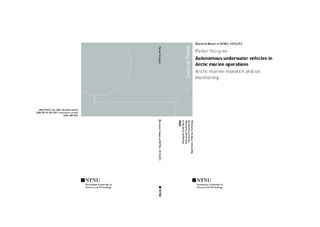| dc.description.abstract | This thesis considers autonomous underwater vehicles (AUVs) in Arctic marine operations. It focuses on their use as a sensor platform in ice monitoring operations and the use of AUVs for Arctic marine research. Arctic AUV operations pose several challenges compared to standard AUV operations, including the presence of drifting sea-ice and navigational challenges in the polar regions. These are some of the issues addressed in this thesis.
Chapter 2 introduces historic Arctic AUV operations, and it presents experiences and lessons learned through these campaigns. Challenges related to communication,navigation, fail-safes, and deployment and recovery, with a focus on Arctic operations are discussed. This chapter also motivates and assess the use of AUVs as a sensor platform for ice monitoring operations. A conceptual guidance and navigation system for Arctic AUVs is presented at the end of the chapter.
Field work and experiments are important to test theory, but also to build experience and acquire knowledge. Chapter 3 presents two Arctic AUV deployments using the NTNU REMUS 100 AUV and the experiences learned from these operations. Two experiments demonstrating the use of unmanned surface vehicles (USVs) as a support tool for AUVs in the Trondheimsfjord are also presented, along with a motivation for the use of such platforms in Arctic marine research.
Since Arctic AUV operations are considered as high risk, with significant costs associated, an Arctic AUV simulator environment has been developed, as presented in Chapter 4. The simulator consists of seven modules, where the modules defining the default guidance and control system, as well as the numerical AUV model, are similar to a regular AUV simulator. In addition, a nice drift model is provided to simulate drifting and rotating ice features. A multibeam echosounder (MBE) simulator is used to sense the ice topography,given as a digital elevation map (DEM). To achieve drift and rotation of the sensed terrain, the final module in the Arctic AUV simulator is a relative position and velocity module, which provides input to the MBE simulator.
A special consideration has been given to iceberg mapping using AUVs in this thesis, asthe detailed topography of icebergs are important to develop iceberg trajectory models, as well as decision support in iceberg management operations (e.g.,iceberg towing). Chapter 5 details a guidance system for determining the main particulars of an iceberg that relies on MBE measurements to determine the location of the edge of the iceberg. The guidance system is implemented as astate machine, starting in an iceberg detection mode. Once an iceberg is detected, an edge-detection algorithm is used to determine the location of the edge relative to the AUV, and thereby to online generate a path along the iceberg edge. The line-of-sight (LOS) guidance scheme is used to follow the iceberg edge and circumnavigate the iceberg.
Motivated by the need to estimate the relative AUV-iceberg position in order to generate a consistent iceberg topography corrected for iceberg drift and rotation, an iceberg mapping navigation system has been proposed in Chapter 6. A simultaneous localization and mapping (SLAM) algorithm based on the bathymetric distributed particle filter SLAM (BPSLAM) is used to track the position and orientation of the iceberg in the global frame. The iceberg mapping navigation filter, implemented using an Extended Kalman filter (EKF) with the SLAM states as input, provides estimates of relative pose and velocity between the iceberg and the AUV. In addition, the velocity of the iceberg is estimated in the iceberg mapping filter. The iceberg SLAM algorithm provides a real-time estimate of the iceberg topography at a fixed resolution, which along with the iceberg drift velocity estimates are important parameters in an iceberg management operation. | nb_NO |
